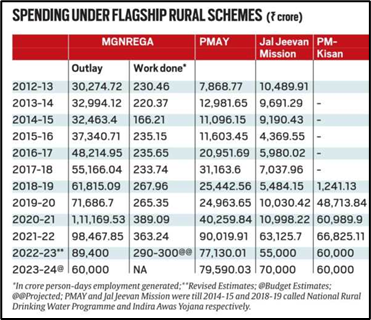
Why in News?
- In the Union Budget 2022-23, the Central government has cut the allocation for the Mahatma Gandhi National Rural Employment Guarantee Scheme (MGNREGS) by 21.66 per cent for 2023-24, attracting criticism from some quarters.
What’s in today’s article?
- About MGNREGS (History, Purpose, Features, Performance, Challenges, etc.)
- News Summary
About Mahatma Gandhi National Rural Employment Guarantee Scheme (MGNREGS):
- The National Rural Employment Guarantee Act (NREGA) was notified in September, 2005.
- In 2009, an amendment was made in the Act to change the name to Mahatma Gandhi National Rural Employment Guarantee Act (MGNREGA).
- Mandate: To provide at least 100 days of guaranteed wage employment in a financial year to every rural household whose adult members volunteer to do unskilled manual work.
- The Mahatma Gandhi National Rural Employment Guarantee Scheme (Mahatma Gandhi NREGS) was created as directed in Mahatma Gandhi NREGA and the means to implement the Act so that the guarantee comes into effect.
- MGNREGS is a Centrally-Sponsored Scheme i.e. the scheme is jointly funded by the Central government and the State governments.
- Concerned Ministry: Ministry of Rural Development
Salient Features of the Scheme:
- Legal Right to Work –
- The MGNREGA provides a legal guarantee for wage employment.
- Every rural household has the right to register under MGNREGA.
- Also, at least one-third of the beneficiaries of the scheme have to be women.
- There are legal provisions for allowances and compensation both in cases of failure to provide work on demand and delays in payment of wages for work undertaken.
- Demand-Driven –
- It is a demand-driven programme where provision of work is triggered by the demand for work by wage-seekers.
- Decentralized mode of implementation –
- The State governments have powers to make rules and amend the concerned State scheme.
- Gram Panchayats (GPs) are to implement at least 50 per cent of the works in terms of cost.
- Plans and decisions regarding the nature and choice of works to be undertaken, the order in which each work is to be triggered, site selection etc. are all to be made in open assemblies of the Gram Sabha and ratified by the GP.
- Annual Report tabled in the Parliament –
- An Annual Report prepared by the Central Employment Guarantee Council (CEGC), on the outcomes of MGNREGA is required to be presented annually by the Central Government to Parliament.
- CEGS is a statutory body set up under Section 10 of the MGNREGA.
- It is chaired by the Union Minister for Rural Development.
- An Annual Report prepared by the Central Employment Guarantee Council (CEGC), on the outcomes of MGNREGA is required to be presented annually by the Central Government to Parliament.
- The MGNERGA covers the entire country with the exception of districts that have a hundred percent urban population.
Performance of the Scheme in last 3 years:
- As per the data available on the scheme portal, 7.55 crore families availed the scheme during 2020-21.
- However, the number came down marginally to 7.26 families during 2021-22.
- In the current financial year 2022-23, 5.21 crore families have availed the scheme till November 26, 2022.
News Summary:
- The Central government has slashed the budget for the Mahatma Gandhi National Rural Employment Guarantee Act (MGNREGA) scheme to Rs 60,000 crore in 2023-24.
- The Ministry of Rural Development has, however, clarified that MGNREGA “is a demand driven scheme”, and “the generation of person days depends upon the demand for the works”.
- The Ministry also added that whenever additional funds are required, the Ministry of Finance is requested to provide the funds.
Possible Reasons behind the Budget Reduction for MGNREG Scheme:
- Over the last three years, India’s economy had suffered massive disruptions.
- Initially from the Covid-induced lockdowns and then,
- The Russia-Ukraine war has led to oil and food price hikes.
- If the next southwest monsoon (June-September) is also normal and the non-farm economy truly recovers then MGNREGA may not require any additional funding in 2023-24.
- Economic Survey 2022-23 on MGNREG Scheme –
- The Economic Survey 2022-23, presented on January 31, said there has been a Year-on-Year (YoY) decline in monthly demand for MGNREGS.
- The reason behind this is that the rural economy is normalising due to strong agricultural growth and a swift bounce-back from Covid-19 pandemic.
- “In FY23, as on 24 January 2023, 49 crore households demanded employment under MGNREGS, and 6.48 crore households were offered employment out of which 5.7 crore availed employment,” it noted.
- The Economic Survey 2022-23, presented on January 31, said there has been a Year-on-Year (YoY) decline in monthly demand for MGNREGS.





